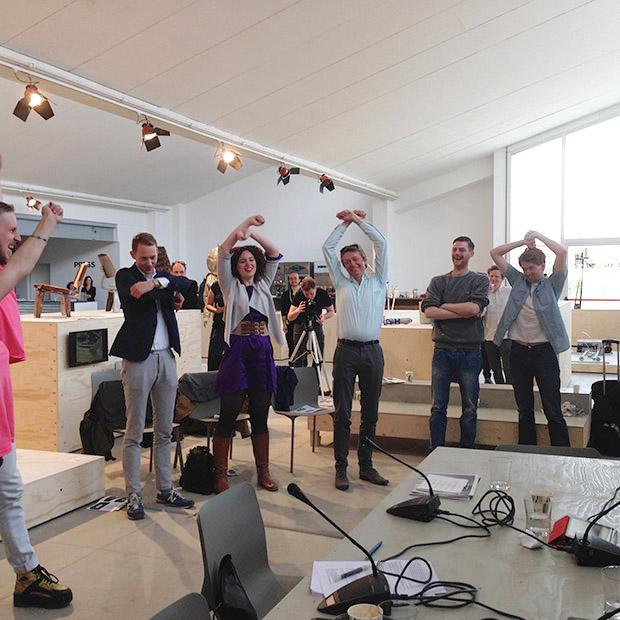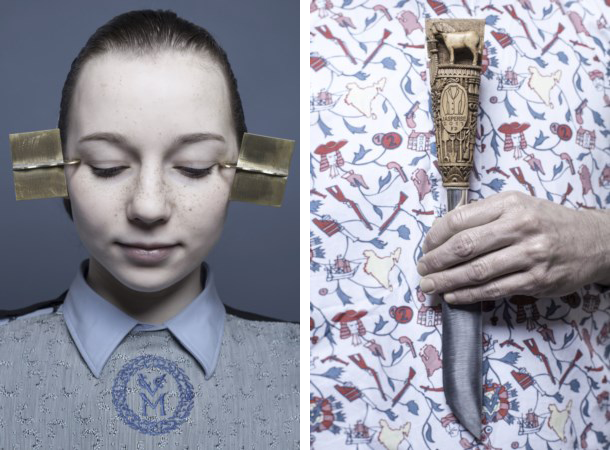by Danielle Arets
BREAKFAST-TALK: RESEARCH OURSELVES, SATURDAY 12TH APRIL.
The final breakfast talk on design research starts quietly but during the session the energy rises, especially when Radio EMMA interrupts the conversation with gymnastics. A good exercise for a conversation that centres around the question how design research can play a more active role in society.

photo: Danielle Arets
As for design researcher Anna Meroni, design researcher at politecnico de Milano, design could play a role in many new fields f.e. working on topics as democracy, good governance or even in creating new job opportunities. “ In a way the very ultimate goal of a designer is to make something aspirational.” Also Bas Raijmakers, Reader Strategic Creativity at Design Academy Eindhoven, stresses that designers can play a more strategic role in society at large. “Their way of thinking can be applied to many fields.” Meroni adjust that a lot of scientific research is being detached from the society and reality. “We as design researchers do the opposite. Design in our understanding is more a social discipline.”
Beauty as a driver for innovation
Does that mean that products are not essential outcomes anymore? questions moderator Tracy Metz. Sarra Ferrari, design researcher, certainly thinks it is important to focus on products. “Of course the outcome of a research can be a text or a service, but products are very powerful tools to communicate.”
Although Meroni is of the opinion that the Salone del Mobile is too much focused on products, she also thinks that beautiful products are an incredibly driver for innovation.
Desiree Majoor from polytechnic of the arts Utrecht, addresses the Tea Set Touch project designed by DAE graduate Inge Kuipers. “It’s a very well designed project that eases the use for people with arthritis. Trough the beauty of the cup you are telling the story.”

Photographer: Edward van Gijn
Collaborative research
How can research really support the design process questions Tracy Metz?
As for design researcher Sarra Ferrari who is collaborating with Technical University Delft it is very important to have access to a scientific body of knowledge. “But not only the knowledge itself also the way of working is very inspiring. Scientist tend to work to one end product, whereas designers easily get lots and come up with various directions. By collaborative research you discover your own strength.”
Innovation on empty stomach
Tracy Metz wonders how designer researchers can earn money from this especially since we are living in a time of sharing and connecting, as Metz puts it “ you can’t innovate on an empty stomach.”
Desiree Majoor points out that we shouldn’t think too lightly on sharing. How do we make money out of it? That’s also on the agenda of the Dutch Topteam Creative Industry of which Majoor is one of the representatives. “Designers should think differently on business models and especially on how they can apply their creativity in a more strategic way.”
Bas Raijmakers also brings in the idea of precompetitive research. Within the Dutch Scientific Programma CRISP (Creative Research Industry Scientific Programme) scientist, design researchers and companies team up in a research process. The programme is funded by the Dutch government.
“The Idea is that research done in such a programme would normally not be commissioned by a company because it is too uncertain what will come out of it. But it is very important because if you do find things out, other things can grow from that. Every company that participates in such an effort should also be happy to share the precompetitive results. Competition can start on the back of that.”
The talk concludes with Thomas Widdershoven who addresses to the project Sea & Land of graduate Gerard Jasperse Zeeland, whose researched found out that wealth in the region comes at a price. On Sea & Land provides a missing link between historians and the public. It visualizes the more difficult aspects of Zeeland’s history using traditional local crafts, while providing added depth to these and giving them a new lease of life. As for Widdershoven it’s a perfect example on how design research can result in a beautiful project and how storytelling is a powerful tool to do so.

Photographer: Lisa Klappe
Article by Danielle Arets
Photographer: Ilco Kemmere
HideFirstImage: